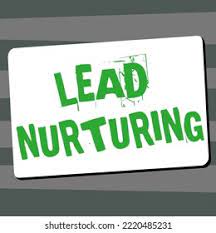More and more businesses are turning to inbound marketing to increase their lead generation, and as a result, the need for a solid lead nurturing strategy has become very evident. A large chunk of your inbound leads, perhaps 90% or more, will not be ready to buy right away. Relationships are essential to the success of any business, and it is important to invest time and energy into them so that they can flourish and last. The success of your inbound marketing efforts, customer retention, revenue, and other metrics can all be positively impacted by a well-executed lead nurturing approach. With automated lead nurturing, the software is used to send messages to prospects based on their actions or on a set timetable. In this article, we will discuss lead nurturing examples, campaigns, and emails.
What is Lead Nurturing?
Lead nurturing is the process by which organizations develop relationships with prospects. It is a crucial part of inbound marketing, which involves attracting clients’ attention through the use of content marketing, social media, and other online communication methods. When potential customer discovers your company, they may not be ready to buy your products or services. Nurturing leads is a successful sales approach because it keeps you at the front of prospects’ minds so they return when they are ready to buy.
Furthermore, lead nurturing is comparable to any other relationship in that the more you put into it, the more you will get out of it. But, if you do not work to strengthen your relationship, you will inevitably drift away.
Understanding lead nurturing
Some leads simply aren’t ready to buy right now. According to some research, just 20% of sales leads are really followed up on, and of those, 70% are unqualified. Nonetheless, ignoring such clues would be a mistake. Even if they don’t make the cut today, 80% of prospects will eventually buy from someone over the next 24 months. In that case, you want them to consider your business first.
Prospects are nurtured through the sales funnel by providing them with informative, relevant information at regular intervals until they are ready to be passed on to the sales team. Lead Nurturing is the safety net at every stage of the purchase cycle, helping guarantee that no income opportunity is overlooked.
In most cases, the goal of lead nurturing is not to generate new inquiries, but rather to convert those that are already well-qualified in your marketing database. As a result, the outcomes of previously acquired leads are enhanced. According to the Demand Gen Report, sales opportunities generated from nurtured leads are 20% more than those generated from non-nurtured prospects.
Hand-raisers are all the inquiries in your system are if you don’t take the time to profile and cultivate them before passing them on to sales. Lead nurturing is the procedure that makes that happen.
Lead Nurturing Strategy
It’s important to remember that the best strategy for lead nurturing is fluid and may evolve over time. It’s possible that a strategy that helps you connect with leads in the past won’t have the same effect today. In addition, if you have the correct customer relationship management (CRM) software, you can automate many of the lead nurturing strategies you need to close a new business.
Lead nurturing is essential to the growth of your organization since it influences a prospect’s choice to become a paying customer. Targeted content, multi-channel nurturing, multiple touches, timely follow-ups, and personalization are just some of the ways leads can be nurtured. Here are some of the lead nurturing strategies you can apply.
#1. Use a Variety of Lead Nurturing Strategies
Setting up a basic email drip campaign to send out mass emails to a list of prospects was the norm for lead nurturing tactics in the past.
As a marketer in today’s world, you’re probably on the lookout for new strategies and tools that might supplement or even replace your email nurturing efforts. Intelligent marketers are now able to implement the multi-channel lead nurturing strategy with the support of robust marketing automation solutions.
Combinations of marketing automation, email marketing, social media, paid retargeting, dynamic website content, and direct sales outreach are the most popular and effective approaches to multi-channel lead nurturing. There are a lot of moving parts, so it’s critical that your sales and marketing departments are in sync and working together to pull this off successfully.
#2. Make Sure You Promptly Follow Up With Leads
The advantages of prompt follow-up calls appear obvious, but most companies still don’t act quickly enough.
A timely follow-up email or phone contact is still often the best approach to turn inbound leads into qualifying sales possibilities, but automated lead nurturing makes it easier to reach larger groups of prospects. That’s because contacting a lead right after they convert on a website greatly increases the likelihood that they will become a sales opportunity.
There is no comparison between the effectiveness of cold calling and a well-timed, well-planned call to an inbound lead. You may deduce the prospect’s interests from their online activity; moreover, you have enough knowledge about the prospect to conduct preliminary research on the company and the prospect’s role within it.
#3. Make Use of Point-Scoring Strategies
Anyone unfamiliar with the term “lead scoring” should know that it is a process used to provide numeric values to leads that reflect how valuable they are to a business.
All you have to do to establish lead scoring in your marketing automation software is to give specific activities on your website, conversion events, or even social media interactions a numerical score. The final score is then used to prioritize which leads require immediate attention from a salesperson and which ones can wait for additional nurturing.
#4. Examine Your Past Lead Nurturing Initiatives
As the adage goes, “history is the only genuine teacher.” Even if it isn’t spot-on, there’s still a lot of useful information to be gleaned from history.
If your company has been around for a while, you’ve presumably established some standard operating procedures. It’s possible that some of these procedures are up-to-date and effective while others could use some updating. Sometimes it’s necessary to take a step back and assess what’s been going well and what could use some tweaking.
If you’ve been with the organization for a while, it’s not a simple task. You may be hesitant to shake up the established order since you are used to things operating a certain way. For this reason, it may be helpful to get the opinion of a recent hire or to investigate lead nurturing operations in other industries in order to gain a new point of view.
Documenting your lead nurturing plan can help you avoid forgetting any steps. Stop trying to cram everything into your head and instead make use of a written document, even if it’s only a Google doc, to keep you on track and give you a bird eye view of the situation.
#5. Facilitate Contact With Potential Customers
Communicating with leads across channels is essential for lead nurturing. Leads currently in the deliberation phase require assistance in making a choice. Since your audience members are diverse, it’s important to provide them with multiple ways to get in touch with you, such as recorded webinars, demos, chats, emails, and more.
In addition, it’s important to present a serious image on social media. One’s online reputation and presence can make or break a lead nurturing approach.
You can still share humorous team activities and memes. Instead, you should use social media to demonstrate that you’re approachable, helpful, and open to dialogue. Have your current contact information ready. It’s annoying when a phone number you try to call is no longer active.
What Are the Objectives of Lead Nurturing?
61% of marketers say that generating leads is one of their biggest issues in B2B marketing. Lead generation is the “first step” on the road to making a sale to a potential consumer. Indeed, it is one of the most important things that marketers do. Just how significant is it? About two-thirds of businesses use new leads as the sole indicator of their content’s performance. And 75% of marketers use lead generation data from their periodic reports to show how their initiatives affect the company’s return on investment. Here are some of the objectives of lead nurturing:
#1. Create a Plan and Establish Some Goals
One must implement a lead nurturing strategy in order to compete with the 35% of B2B marketers who already have one. To begin, your lead nurturing campaign needs objectives. The next step is to design a strategy to address each lead individually, taking into account their current sales funnel position and the value your company can bring to them.
Time and energy equal to that spent on lead generation should be devoted to this phase. It’s best practice to have numerous lead nurturing techniques to cater to the various subsets of your ideal customers.
#2. Determine Your Potential Customers
The first step in segmenting your lead nurturing efforts should be identifying the best leads you have for closing a sale. It is your responsibility to figure out who will constitute each group and what you will be able to sell to them.
To get started, it’s important to gather as much information as possible about your target market’s problems, wants, and desired outcomes before developing a solution. Figure out how to get people excited. After that, develop fictitious representatives of your ideal customers (or personas). Secondly, divide your marketing materials into groups according to the types of people who would be interested in them and the benefits they could expect to receive.
All of your segments should be considered when establishing long-term objectives, but each segment requires a tailored strategy to meet its specific demands and guide them through its customer journey.
#3. Use Email to Nurture Prospects
The best way to re-engage a lead is through email nurturing campaigns. This is because (1) lead-nurturing emails result in 4–10 times more click-throughs than normal blast emails, and (2) email marketing solutions provide greater value for money compared to other kinds of advertising.
You may save time, money, and human resources by automating your email marketing strategy. Lead nurturing necessitates the creation of drip email campaigns, which send out a series of increasingly relevant, consistent, and timed emails to leads as they progress through the sales funnel.
The objective is to locate the appropriate contacts. Start with a welcome email, then send an onboarding email, and then schedule educational, promotional, and re-engagement email campaigns at regular intervals based on time and the buyer’s position in the sales funnel.
#4. Make Your Experiences Unique
Even when making a purchase from a B2B company conducting business in a 47th-floor conference room, customers still expect a tailored shopping experience. 91% of shoppers say they are more likely to buy if they are given personalized recommendations and discounts, and eighty percent say they are more likely to buy if their shopping experience is tailored to their individual preferences.
A sensible strategy for making touchpoints feel less generic is to deploy less formal information, call clients by name, and personalize content to the interests and requirements of individual customers, thereby mimicking the salesperson-consumer connection one may experience in a physical store. A further effective strategy is to install an attribution-based personalization program on your website. It plots the paths of visitors and immediately presents them with customized content that has been shown to increase conversions.
Lead Nurturing Campaigns
Creating lead nurturing campaigns in your marketing automation software is a great way to start communicating with potential customers at the beginning of their buying process and continue doing so until they are ready to buy. To nurture is to care for, and successful lead nurturing campaigns can demonstrate your commitment to those who might one day become customers.
Prospective customers’ actions can be tracked through lead nurturing and lead management systems. Marketers can then tailor their content to better meet their target audience’s needs and preferences. It’s useful for marketers since it allows them to identify and cater to their target demographics’ individual wants and needs.
What is Lead Nurturing Campaigns Examples?
The objective of lead nurturing campaigns is to encourage interactions, creativity, and ultimately sales. Even if there are additional points of contact, the ultimate objective remains the same: to get their attention, provide them with relevant information, and ultimately make a sale.
This is accomplished through a series of direct actions. After all, a welcome message rarely results in a sale. From top to bottom of the sales funnel (or from start to finish of lead nurturing campaigns), each stage should flow naturally into the next. One after the other, without skipping a beat. Therefore, let’s begin at the very top and work our way down. Here are a few examples to start the lead on their lead nurturing journey and get them engaged with your company.
#1. Welcome Campaigns
It’s common practice for a company’s initial interaction with a potential customer to be a warm welcome email. Simply said, it’s a short message that expresses gratitude and welcomes the prospect to the brand. A welcome email should be sent out as soon as possible after gaining a new free user, email subscriber, newsletter sign-up, or blog subscriber. Keep in mind that the goal at this point is interaction, so focus on providing the lead with a message that is both kind and helpful.
#2. A Campaign Aiming for the Forefront of People’s Minds
Those at the very beginning of the sales process funnel, who are not yet ready to buy, are the intended targets of a top-of-mind nurturing campaign. Educating these individuals about your business is essential if you want them to make a purchase.
We can call it an “Awareness” campaign. The goal is to avoid losing the potential customer to a last-second snipe from a rival. Throughout the course of a long period of time, the sales team stays in regular contact with the lead and provides them with helpful content.
Louis Vuitton, a maker of expensive handbags and apparel, is a prime illustration of this. Without much advertising, they have successfully positioned themselves as a market-leading clothing brand. Their premium costs, distinctive branding and design, and lead nurturing, top-of-mind advertising (which may be a touch obtuse) all contribute to this effect.
#3. Re-engagement Campaign
The unfortunate reality is that not all of your leads will convert. Few will make it past the initial stages. But, that is not to say that there is no hope. It’s possible that your lead database is stuffed to the gills with inactive users, subscribers, and leads. To get these leads back into the sales pipeline, re-engagement campaigns are launched.
#4. Competitive Campaign
Using campaigns that highlight your product’s unique selling points, may help differentiate it from the competition. There are many methods by which this could be accomplished. Articles, movies, and landing sites that examine and contrast two or more aspects are the most typical examples.
We all remember the Mac versus. The smart and competitive PC commercials of yesteryear, and how much we all loved them. Simple advertising campaigns weren’t going to cut it if Apple wanted to compete with its greatest rival. Rather, they were courteous about the PC’s flaws before explaining how the Mac is the solution.
How Do You Start Lead Nurturing?
- Promote your business via email.
- Extend your content marketing efforts.
- Participate actively in online communities
- Harmonize your company’s sales, advertising, and customer service departments…
- Get responses from respondents.
- Ahead in the score
- When a transaction has been made, it is important to follow up with your leads.
Lead Nurturing Emails
Emotional appeals are frequently used in lead nurturing emails, such as through the use of social proof and user-generated material. They may simply provide substantial price reductions as an additional incentive to buy. In order to persuade consumers that they should purchase their items, marketers employ a lead nurturing technique. Users who aren’t nurtured may abandon the shopping process or go elsewhere to make their purchases.
Due to the adaptability of email campaigns and the ability of marketers to tailor their communications to their objectives, lead nurturing via email is extensively practiced.
What Is a Lead Nurturing Email?
A lead nurturing email is one that is sent to a potential customer who has expressed interest in your business’s offerings but has not yet made a purchase.
These emails cultivate a relationship with the lead and keep them engaged in your business until they buy. Emails for lead nurturing can be sent as part of a larger email marketing effort, or they can stand alone as a standalone strategy. Also, read Best Email Marketing Campaign Examples.
Tips for Writing Effective Lead Nurturing Emails
- Adjust your email signature to reflect your personality
- Put several forms of content to the test
- Track email engagement
- Merge email with other forms of communication
What Are the Benefits of Lead Nurturing?
The goal of lead nurturing is to eventually convert prospects into paying customers. In fact, leads that are nurtured make purchases 47% greater than those that aren’t. Here are some benefits:
#1. Allows You to Make More Precise Campaigns
Lead nurturing allows you to tailor your marketing efforts to each individual lead based on their demographic characteristics and areas of interest.
This demonstrates your ability to relate to people by meeting their needs. They will be more receptive to becoming paying consumers as a result.
Conversion rates can increase by a factor of 5 once a hyper-personalized campaign has been launched. Have you heard that the response rate to automated lead nurturing emails is 4-10 times higher than that of email blasts? You are more likely to receive a response from your leads if your emails are personalized.
#2. Boosts the Reputation and Popularity of the Brand
By maintaining consistent communication with leads at each interaction, lead nurturing helps you earn their trust. If you want customers to buy from you, they must trust your organization and its products or services.
Around 63% of those who inquire about your business probably won’t buy from you for at least three months. However, it’s critical to maintain contact with your leads by giving them relevant information and channels of communication.
They will trust you more and be more willing to buy from you in the future.
#3. A Lead Nurturing System Can Be Automated
One of the many benefits of lead nurturing is that it may be carried out mechanically. As a result, you can build up lead nurturing campaigns and let them run in the background while you focus on other elements of your business.
You may automate lead nurturing emails at specific times by establishing consumer touchpoints. This allows you to continually communicate with both new and established prospects, allowing you to cultivate both.
#4. Facilitates the Collection of New Prospects
Also, lead nurturing aids in increasing brand recognition and attracting new leads. By introducing your leads to your brand and establishing your credibility as an industry expert through the distribution of useful content, you may increase the likelihood of them converting into customers.
In the long run, this can make consumers more comfortable with your company’s name and increase the likelihood that they will do business with you.
Conclusion
One essential part of any advertising plan is lead nurturing. Customers’ problems are opportunities to demonstrate expertise and earn their trust, boosting your company’s profile and sales.
Even though much of this can be automated, it’s crucial to maintain regular marketing efforts and personal contact with clients. Using a marketing automation platform, it is possible to develop a program of automatic and personalized lead nurturing for your company.
That’s a great way to get more clicks from your current customers, and it’ll also attract more potential new ones. In the long run, this will help you save time and money while also increasing revenue from your current clientele.
Lead Nurturing FAQs
What are the 3 elements of an effective lead nurturing strategy?
- Provide persuasive communication to target audiences
- Use a wide range of content types
- Timely marketing communication is essential.
What are the 4 pillars needed to pre qualify a lead?
- The best salespeople do not try to persuade their consumers to buy; instead, they facilitate the purchase process.
- Investment. It’s crucial to know if a potential customer can afford to buy your product.
- It’s one of a kind
- Capacity to command respect.
Similar Posts
- Sales Cycle: The 7 Stages & Steps for Successful Sales Results (All You Need)
- Tasks leaders should never delegate
- LEAD MANAGEMENT SYSTEM: Definition and How It Works
- Marketing Automation: Best Marketing Automation Software and Tools.
- LEAD SCORING MODEL AND BEST PRACTICES






